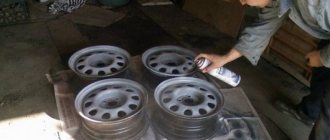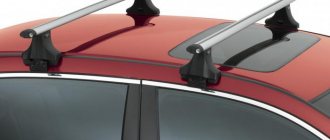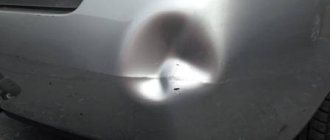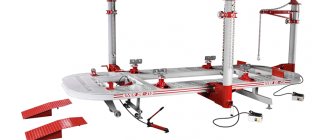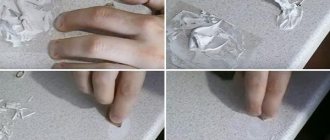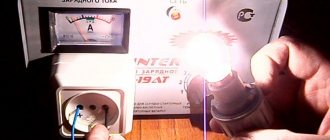Over time, high-pressure washers, primarily used for cleaning cars, have become increasingly widespread in domestic markets. Using a similar device, you can wash both the body part and the bottom and engine compartment. The undoubted advantage of this device is that a precisely directed jet is used to remove dirt from the surface of the car without the use of a powerful water pump. Do-it-yourself high-pressure washing is a very profitable idea, allowing you to significantly save money spent on periodic washing of the car. If we take into account domestic weather conditions, when at any time of the year there is dirt on the roads in any state of aggregation, then such a wash will pay for itself very quickly.
The easiest way to do your own washing is to use an air compressor.
What is a pressure washer?
Today, you no longer need energy and time to fight dried-on dirt and dust that has clogged up in nooks and crannies, because every year new models of high-pressure washers .
These devices are used for washing windows, cars, walls and doors of houses, barbecues and other objects that are difficult to clean with a rag or brush.
Strong water pressure copes with this task much more effectively and saves money spent on washing the car at a service center; water consumption is also minimal. Therefore, having such a sink in your arsenal is useful for everyone.
Popular means
Of the well-proven compositions, we can recommend:
- The “Motorraum-reiniger” product from Liqui Moly is very popular among car washers;
- “Car shampoo for engine” produced by JSC “VNIIkhimproekt” gives excellent results;
- Turtle Wax's High Tech Engine Clean is also excellent;
- The liquid with the long name “Mean for washing engines and units” has also not disappointed anyone.
Usually one bottle is enough to wash the engine, so, as you can see, the costs are not too high.
Main components
Since we do everything from improvised means, problems may arise with such a parameter as reliability. I believe that any sink or foam generator should be assembled in accordance with GOST and other requirements. If you violate all the recommendations and sculpt a structure from the first spare parts you come across, it’s better not to start.
If you are ready to act consistently and competently, then maybe something good will work out. Homemade car washes are not a myth at all. A lot of people, including my friends, collected them. They work well. Although my foaming agent works no worse. Yes, I bought it and I'm not ashamed of it.
So, since we are talking about homemade sinks, let's see what components they are assembled from.
- Pump or pump. The first priority will be to find a pump. Since a sink is a water supply device, there is no way to do it without a pump. Moreover, so that water comes out through the nozzle under high pressure, capable of removing dirt from the surface of the machine, we select the pump at 150 bar. Some charge more, but this is unnecessary. Otherwise, the paint will come off along with the dirt. The block head must be made of brass or bronze. Such materials are least susceptible to corrosion, and therefore the device will last a long time. Supplying 15 liters of water per minute is enough to thoroughly wash your car.
- Electrical engine. The next in line will be a 220V electric motor. In addition to it, you need a condenser unit so that the sink starts without problems. The higher the rpm, the better the performance. Pumps that are too fast and produce a high speed will wear out quickly. Don't take them. A consumption of 2-3 kW and a rotation speed of no more than 2000 rpm is considered optimal.
- Clutch. It is needed to connect the pump to the engine. Some people also install a belt drive in one stage. With the help of this gearbox, the speed and load of the engine with the pump are balanced. The gear ratio must be selected based on the required output parameters.
- Water container. Use a tank that you can power from a constant source of water. This could be a regular tap or a well, for example. If the water is dirty, install a filter at the inlet. The main reservoir will serve to add car washing shampoo.
- Performance regulator. A special valve must regulate operating parameters and, if necessary, redirect unused water pressure into the container. This reduces the load on the pump.
We've sorted out the basic elements. But there is also a hose, nozzles and other components that are part of a homemade sink. Or think about which one to choose among ready-made sinks sold in stores.
Composition of car shampoo
In order for the car body to sparkle without serious financial costs and physical effort, you need to know what modern car shampoos consist of.
. They include:
- foaming agents – speed up and simplify the removal of dirt;
- anti-corrosion substances – provide additional body protection;
- additives that reduce water hardness;
- synthetic components: propylene, ethylene;
- wax, fats of natural origin;
- polishing agents;
- flavorings (optional).
But the most important substance is the surfactant
, which determines the pH of the shampoo. Its content should be in the range of 5–30%; low alkaline elements can be used.
When testing a detergent composition, to prevent damage to the paintwork, it is necessary to apply it to a small area. If multi-colored stains appear, you should quickly remove them with a soft cloth. It must be remembered that a high concentration of substances leads to damage to paint and chrome on finishing elements.
External car wash units
External components are mounted on a frame, which is better to make yourself or choose a suitable ready-made structure. Usually the frame is made on the basis of a profile or curved pipe. You can install wheels on the bottom so that the sink is not stationary, but mobile. Stops, handles and clamps will help you move the device.
- Hose. If you have sorted out the water intake, you need an element through which the liquid will begin to flow to the machine. Choose reinforced rubberized hoses or plastic products. Just make sure the hose is durable and has tight connections to the water intake. If necessary, you should be able to quickly repair the hose and change it.
- Connections. It is better to connect areas where elements are connected to each other and come into contact with water using fasteners made of corrosion-resistant materials. For example, bronze or brass.
- Gun and nozzle. You can take a ready-made sandblaster or another suitable gun that has a nozzle. Outwardly they resemble pistols at gas stations. The water jet should only be released when you press the button. It’s better to take a ready-made gun and not worry. My advice to you.
We do everything consistently and carefully, connecting the elements tightly together. In fact, selecting parts and creating a full-fledged sink from them is not an impossible task.
But you will still need a cutter to cut the holes, a whole set of different components. It is far from certain that they will be at hand or suitable in size, type of material, and so on. Someone makes sinks from NSh 10 (gear pump) and is happy with the result. Others twist and turn something, but in the end they go to the store and buy a foaming agent, connecting it with the purchased branded sink. Although a foam generator can be made from a compressor and auxiliary mechanisms, I would prefer a ready-made product.
In some cases, it is better to think about which sink from a leading manufacturer to take to wash your car, rather than spend several days unsuccessfully trying to assemble a sink from scrap materials.
I am not at all opposed to making useful things with my own hands. But in terms of washing there are many pitfalls. As for me, it is better to spend more money and less time on a proven Karcher factory car wash, for example, than less money and more time on a homemade device. It remains to be seen how this homemade product will work and what surprises it will reveal during operation.
The rating of factory sinks clearly demonstrates the leaders of the segment. Will you be able to achieve similar characteristics to such devices by doing the washing yourself? Hardly. Can you save money? Probably yes.
Foam generator design
Structurally, the foam generator is very similar to a conventional garden sprayer; their circuit diagram is almost the same.
But there is one significant nuance - penogen is equipment that operates under high pressure. The main components of this equipment are:
- Cylinder (volume varies - from 25 to 100 liters).
- Mixer.
- Gun.
- Connecting hose.
Large equipment, with a large capacity cylinder, can be installed on a transport trolley to ensure easy movement.
Since the equipment operates under high pressure, the cylinders are made of stainless or ordinary steel, but with mandatory coating with anti-corrosion agents. In some factory models, a measuring ruler is installed on the cylinder, which allows you to control consumption and timely refill.
Penogen cannot work independently, since it requires a supply of compressed air. For this purpose, there is a fitting on the cylinder for connecting the compressor. Typically the operating pressure for a foam generator is 5-6 Bar. To control the pressure, a pressure gauge is installed on the container; pressure adjustment is carried out using a pressure regulator included in the design.
Foam tablet
The main element of the mixer is the so-called foaming tablet. In reality, it is a fine-mesh mesh, folded in several layers and made of corrosion-resistant wire. It is installed in a housing mounted on the cylinder. And it is to this that the supply hose is connected. This tablet ensures that the primary foam supplied to it is broken down into a finely dispersed high-density fraction.
And then the finished foam is fed to a gun, which is used to apply it to the surface of the body. This gun is equipped with a foam supply regulator, which allows you to set the output jet parameters.
Advantages of homemade equipment
If there is no financial opportunity to purchase a device, or there is a desire to assemble high-pressure washing equipment with your own hands, the instructions given below will be of interest to you. Before you make a high-pressure washer, you should know about the advantages of the technology:
- low financial expenses;
- possibility of modernization;
- functionality at the level of production technology;
- fast production;
- operational simplicity;
- high efficiency;
- no need for spare parts and no additional expenses.
Using the equipment, it is possible to effectively, quickly and efficiently wash away contaminants of any degree of complexity. You can clean various surfaces of the car body. A homemade high-pressure washer, made and operated with your own hands, eliminates damage to the surfaces being treated. This quality favorably characterizes the cleansing technique in the eyes of the user.
Advantages and disadvantages
This mini high pressure washer has important advantages:
- the components of the liquid are converted into foam without loss;
- the output creates a stable mixture with excellent cleaning properties;
- foam consumption and parameters can be adjusted;
- One charge of a 50-liter cylinder allows you to wash from 10 to 15 cars.
But there are a couple of disadvantages:
- you will have to constantly refill the cylinder with compressed air;
- you need to install a compressor.
Having a good sink at your disposal, using a special adapter, you can combine them into a common device. An excellent solution for those who have already acquired a car wash and want to increase the efficiency of their car washing equipment.
Some even create a homemade apparatus from a fire extinguisher or other improvised means. There are even a number of special videos where everything is clearly shown. But I would not recommend doing such things. If you want a device for supplying foam and a really high-quality car wash, spare no expense and buy yourself a good generator, even a Chinese one.
But revision is another matter. When buying a household or professional foam cleaner, many note that some spare parts are insufficiently effective.
We make equipment ourselves
First of all, you will need to choose a suitable pump for washing. If you plan to operate the equipment for commercial purposes, choose industrial equipment. The main principle remains the choice of a plunger pump equipped with ceramic pistons. The crank mechanism increases the service life. The main parts of a high pressure washer are:
- washing filter;
- hoses;
- additional nozzles;
- water containers;
- detergents;
- sandblasting for washing;
- durable wear-resistant body;
- High pressure pump;
- engine (gasoline or electric).
The principle diagram of how a homemade high-pressure washer works is as follows: water is transported to the container from a special container or water supply, and then pumped through a pump. The maximum load provides pressure up to 160 bar. Water is supplied via a hose to a gun with a nozzle. Let's look at the main stages of manufacturing a high-pressure washer:
- The container is equipped with a pump, and the connections must be completely sealed and durable. Fixation involves the use of couplings.
- On the other side of the tank you will need to fix a hose that will supply water.
- The hose is equipped with a tip that directs the water stream.
An auto-loading valve, available in two variations, will need to be connected to the pump. The first type is represented by a closed valve. The system releases pressure after closing the gun, and then water is pumped from the outlet to the inlet. It is recommended not to operate the device for more than 3 minutes. The valve with inlet is convenient. The liquid is transported through the collector to the container or to the sewer immediately after the pressure is released (depending on the connection option for the sink).
There are two ways to connect the motor to the pump . If you have a motor with a full shaft, it can be connected directly to the pump. The motor shaft is placed on the front bearing, creating additional load. This technique shows the most economical results. If you make a sink with such an engine with your own hands, it will have a significant service life between repairs. This is caused by high starting loads. It happens that it is not possible to remove the pump shaft from the engine. In this regard, it is advisable to install a soft starter.
Another method of coupling the motor to the pump is provided, in which a clutch is used. It is used as a cushion that softens the shock during equipment startup. The coupling serves as a protection that prevents the shafts from being damaged. In order to reduce the load during startup, a soft start can be used. Thanks to this element, it is possible to gradually increase the power in the system.
The sink is mounted on a frame. Installation of the electrical component, the gun with the nozzle, and the high-pressure hose is carried out sequentially. It is important that the equipment in question is installed in accordance with the parts manufacturer's recommendations.
Follow the established algorithm for assembling the device, take into account the load present when tightening the bolts. Also use anaerobic fixatives.
The sink must be connected to the water supply system using a hose. The connection hose must be at least 7 meters long. The length of the hose allows you to smooth out pressure drops in the water supply. Provide a filter for washing. It is recommended to use a hose with a check valve, which increases the operating pressure.
Other parts needing attention
In order for a homemade high pressure washer to be assembled correctly with your own hands, you will also need other components.
Additional items:
- filter element - a fine mesh that prevents the entry of dirt particles and debris;
- capacitor, single-stage gearbox - optional components, but they make it easier to start, improve the quality of work, and productivity;
- compressor – can be used as a pump, the basis for a car wash, greatly simplifying assembly;
- performance regulator, unloading valve - parts that ensure safety and efficient operation;
- clamps or hydraulic sealing - will make the connections airtight;
- elements in contact with water are selected from corrosion-resistant alloys.
Having completed the collection of spare parts, you can begin fastening the elements and installing them on the frame. It is important to maintain the ability to repair equipment by more often using threaded connections.
Homemade mini-wash project
The proposed mini-wash project includes the following set of basic elements:
- pump;
- electric motor;
- coupling for connecting the first two positions;
- container for water and detergents;
- frame;
- gun with nozzle;
- high pressure hoses;
- nozzles
The operating principle of the manufactured sink is very simple. After connecting to the water supply, the water enters the container, where it is pumped using a pump.
Next, the water is supplied through a hose to a gun with a nozzle. If the gun is equipped with a special nozzle, you can change the nature of the water flow, which is determined depending on the surface being cleaned.
The principle of operation of the foam generator
DIY foam generator
The operating principle of the foam generator is very simple:
- The washer fills the cylinder with a solution of water and foaming agent (detergent). The neck is then tightly closed, which ensures the container is sealed.
- A compressor is connected and air is pumped to the required pressure.
- When the gun valve is opened, air begins to squeeze out the solution through the nozzle, where primary foaming occurs.
- Moving at high speed, the foamed solution hits the mesh of the foaming tablet and, passing through it, separates, which is accompanied by the formation of fine foam.
- The finished foam is fed to the gun and then through the nozzle this stream is supplied to the surface of the body.
- If necessary, the washer can adjust the flow on the gun (make the spray front wider, increase the speed of the jet).
It is noteworthy that another equipment for contactless washing, a sprayer, works approximately on the same principle. But unlike a foam generator, at the exit from the gun it forms an emulsion, whose cleaning effect is lower than that of foam.
The difference between them comes down to the different application guns used. Emulsion is a slightly different state of liquid than foam, so to spray it you need a nozzle with an enlarged hole. In addition, it is impossible to adjust the emulsion supply parameters of the sprayer, that is, there are no adjustment elements on the gun. These nuances will help you easily distinguish a foam generator from a sprayer.
The main advantages of the foam generator are:
- economical consumption of detergent;
- the resulting foam has excellent cleaning function;
- possibility of adjusting the jet flow;
There are two main disadvantages of this equipment - large overall dimensions and the need to connect a compressor. Of these qualities, the foam generator is considered equipment for professional car washes, but not very suitable for home use.
Preparing material and tools
To make a mini-sink you will need the following components.
The pump is one of the main components of the sink. The performance of the device must be quite high (pressure range: 100−200 bar). When choosing a pump for a mini-wash, you should also pay attention to the material it is made of. It is desirable that the cylinder head be made of brass, the pump pistons made of ceramics or durable metal. The period of operation of such a pump will undoubtedly please you.
A high pressure washer cannot be imagined without an electric motor. Obviously, with an increase in engine speed, the performance of the pump, and therefore the device as a whole, also increases. However, don't go overboard. The optimal electric motor power is from 2 to 3 kW, rotation speed is 1500-2000 rpm. To ensure reliable engine starting, an additional capacitor bank can be used.
The coupling connects the pump to the motor. The so-called soft coupling is the most acceptable option. It plays the role of a fuse in case the pump or motor jams, and can also compensate for minor axial misalignment of the shafts.
Latest posts Chainsaw or electric saw - what to choose for the garden? 4 mistakes when growing tomatoes in pots that almost all housewives make Secrets of growing seedlings from the Japanese, who are very sensitive to the soil
The optimal volume of the water tank is from 4 to 20 liters. It is recommended to install a special filter (fine mesh) at the outlet of the tank, which can trap particles of dirt and debris, preventing them from entering the pump.
The basis for fastening the sink elements is the frame. The traditional material for its manufacture is curved pipes. Wheels and a stop are often attached to the frame so that the mini-wash can rest on them during operation. The handle on the frame will ensure the movement of the device around the territory.
For high-pressure hoses, I recommend using reinforced hose (plastic or rubber). Remember, hose connections must be sealed, non-corrosive and easy to disassemble.
A pistol with a nozzle performs a rather serious function - it forms the shape of a water jet. When you press the handle, liquid is supplied, this allows you to save water. It is better to buy the tip ready-made so as not to “rack your brains” over the design of the shut-off valve.
The device is usually equipped with a nozzle (or several), which creates a jet that is most convenient for washing various surfaces. As a tool in the process of constructing the device, you will need a knife, scissors, and sealant.
What parts are needed to assemble a car wash?
Setting up a mini-wash is a simple process. The work begins with the selection of parts for subsequent assembly of the structure. The working part must be assembled from high-quality, proven materials. The components, with the exception of the pump, do not have to be new. But the serviceability is first checked to avoid breakdowns.
Basic washing elements:
- The pump or motor that creates water pressure is the main part. When choosing, pay attention to performance and the ability to create pressure. For infrequent use, at home, a pressure of 100 bar is sufficient. When installing additional equipment, nozzles, up to 160 bar is required. Average figures vary between 100–200 units.
- The electric motor is the power source of the system. When assembling it yourself, it is recommended to choose single-phase devices with a potential of 220V. They are safer and more accessible.
- Coupling – necessary to connect the pump and the power plant. It is preferable to have models that can perform the functions of a fuse and balance the misalignment of the shafts along the axis.
- Housing, water container – ensures a uniform supply of water masses. Tanks made of durable plastic or metal are used.
- The frame is the basis for securely fastening the elements. Often additional wheels are installed at the bottom for mobility and ease of use.
- A gun with a nozzle and hoses are required to supply water. The hose chosen is high-quality, reinforced.
- Nozzles - used to change the nature of the water flow. There are many models used to solve specific problems.
You should not skimp on the quality of parts - this will affect the performance of the device.
Do-it-yourself mini-sink assembly technology
One of the most important nuances when assembling a sink is the creation of grounding. For these purposes, use a flexible three-core wire (double insulated) and a plug with a grounding terminal. In this case, the outlet is also grounded through the circuit .
The next step is to mount the sink on the frame, i.e. we sequentially do the following:
- We install electrical equipment.
- We mount the gun with the nozzle.
- We install high pressure hoses.
When equipping a water tank with a pump, make sure that all connections are strong and tight. It is also very important that the device is installed in accordance with the recommendations of the parts manufacturers.
We connect the high-pressure washer to the main water supply using a hose (an acceptable hose length is at least seven meters).
How to properly wash the engine
- Before washing, the engine must be allowed to cool down if it reaches operating temperatures. Ignoring this requirement may lead to the fact that under running cold water there is a risk of rapid cooling and subsequent deformation of the heated cylinder head.
- The next step is to disconnect the terminals from the battery. As for cars with a hybrid engine, then it is necessary to clarify the location of the batteries on a specific model. It should be added that often the batteries of hybrids are located in the rear of the car, so washing the engine on a hybrid car in this case does not pose any danger.
- Next, certain elements in the engine compartment must be protected from moisture. To do this you will need the above polyethylene and foil. First of all, the engine air intake is closed. A bag is perfect for this, which should additionally be wrapped with tape or tape to ensure secure fastening.
How to use the mini-wash
To ensure your washer works properly , follow these recommendations.
- Be sure to check the operation of the washer before you start using it, this will save your time and health.
- Clean and change the filter installed in the car wash after each use.
- If the washer uses electricity to operate and the source is unstable, provide it with a battery.
- Do not let children use the sink.
- If repairs are necessary, do not hesitate to carry them out. Replace damaged sink components.
- Update the device gaskets.
- Protect your sink from temperature changes.
Types of washers
The main division of these devices distinguishes two main categories: those intended for home use and those that will be used in professional car washes.
Since the intention is to create a car wash that will meet personal needs, it is worth focusing on the former. Among the products available in the market are electric, exhaust and hybrid washers.
IMPORTANT. In order to correctly decide on the unit, you need to know exactly in what areas it will be used.
Safety precautions when using the sink
When using a homemade sink, you must follow safety rules, which will also extend its service life.
It is imperative to take into account the operating cycle limit of the device. So, if you purchase a ready-made device, then the instructions contain information about how long it can work. The cycle can last 20, 30 minutes or an hour, it all depends on the performance of the device. And if you do not comply with the specified time interval in the work plan, the device will overheat and break down.
It is best to use a homemade device for no longer than twenty minutes. You can also calculate the time of use yourself; it all depends on the amount of material used to assemble the tank and its quality. The more plastic is present in the design, the shorter the operating cycle will be.
It is not recommended to pour process or river water into the tank, since they contain a large number of elements undesirable for the device, which negatively affect the quality of its operation.
prevent small particles or chemical elements from entering the tank , and to protect it from mechanical damage, it is recommended to install an additional filter for water purification.
It is also extremely important that all electrical equipment is grounded using a three-wire insulated flexible cord and a plug with a grounding terminal. The entire structure and filter must be cleaned periodically.
To successfully wash a car at home, many people prefer to purchase expensive Karcher equipment. But you can save a lot of money by assembling its analogue with your own hands. How to do this was discussed above.
Recipe 3 – car shampoo for contactless washing yourself
Shampoos for contactless washing have lower viscosity and greater chemical activity. Within 5-10 minutes the foam retains its specified properties. During this time, the dirt dissolves and is absorbed by the detergent composition, after which the dirty foam is removed from the surface with a stream of water.
When caustic soda and HEDP acid are mixed, heat is generated. You should not be afraid of this - the process proceeds normally. It is not necessary to wait until the solution cools; surfactant AC-1 can be added without fear. Once again, we need to remind you that it is very important to mix the composition thoroughly after adding the next component. When the mixture acquires a uniform color, the shampoo concentrate is ready.
Practice shows that it is not worth storing such a product for more than a month.
After this period, the washing mixture begins to lose its qualities. The shelf life can be extended by adding preservatives to the shampoo, but this is a different, more complex technology.
Professional car washes
Professional devices are characterized by increased reliability and excellent performance. But they are not available to everyone, as they are very expensive. And there is no need to talk about their compactness. The average weight of such devices is close to 100 kg. Even though they are mounted on wheels, they are not at all easy to move. The main advantage of professional AEDs lies in their characteristics:
- Great performance. A good sink flows more than 600 l/h.
- Such washers provide pressure of more than 200 bar.
- The sink is powered by a regular three-phase power supply.
- The device is capable of heating water independently.
- It has a built-in foam generator and a built-in tank for detergents.
Professional car washes can work without interruption for a long time.
Despite the attractive functionality, such devices are a specific product, and ordinary car enthusiasts almost never buy them. For ordinary people, household mini-washes are enough.
Household AEDs
Household mini-washes can be used not only for washing car bodies, but also for solving the following problems:
- Clearing clogged drains.
- Cleaning garden tools.
- Cleaning the local area from construction waste.
- Cleaning garden paths.
- Cleaning walls, house facades and fences.
All household high-pressure car washes are divided into subgroups according to the following criteria: water temperature, type of power supply, power.
Household mini-washers can receive heated water from outside or heat it themselves. Unheated devices are slightly less expensive than heated devices.
Depending on the type of power supply, household high-pressure car washes come in petrol and electric.
Devices with gasoline engines are considered close to professional car washes. That's why they cost accordingly. The cheapest gas-powered car wash will cost the buyer $600. The most expensive one sells for $5,000. It is not surprising that they are not popular in our country.
Household high-pressure car washes with an electric motor are the choice of a simple car enthusiast. Based on their power, such devices can be divided into 3 groups:
- Compact. Such mini-washers are inexpensive, small in size and light in weight. They allow you to solve the simplest car care tasks. Their engine power is small: from 1.3 to 1.5 kW. The pressure does not reach 120 bar. Capacity 260 l/h. A classic example of such devices is the K2 and K3 models from the Karcher brand.
- Middle class. These devices can solve most household problems. Power – 150 bar with an energy consumption of 2 kW. Impressive performance, but they are not the main advantage of these devices. Consumers love them for their liquid-cooled metal pumps and long high-pressure hoses, which allow them to easily walk around the car while washing.
- Top class. These high-pressure car washes are very close in their characteristics to professional entry-class devices. Unfortunately, they have come closer not only in power and performance, but also in price.
Choosing a mini-wash
When choosing a household AED, you should consider the following parameters:
- Performance.
- Pressure.
- Pump material.
Plastic pumps do not last long and are installed in inexpensive, low-performance devices that can be used to wash a bicycle, motorcycle or garden cart. It is not enough to wash a car. More precisely, with the help of such a car wash you can wash your car, but it will take a lot of time due to its low productivity.
The car can be easily washed using a pressure cleaner with a brass or silumin pump . These are middle class household appliances. Their performance and pressure are sufficient to wash any passenger car. Essentially, it is the best choice for home use.
Of course, if a car enthusiast has extra money, he can buy a high-class household high-pressure car wash, but for the average car enthusiast this is a luxury.
Important parameters
Once we know which power source for the washing machine will suit our needs, we need to pay a little attention to its technical parameters.
The most important values to look for when making such a purchase are water efficiency and pressure.
Capacity is indicated in liters per hour. For domestic use, this parameter should be from 300 to 350 l/h. The second very important parameter is the pressure of the pumped water. This value is given in bars or megapascals and should be between 80 and 160 bars.
Additionally, aspects such as the size and weight of the device are important elements to pay attention to. You don't want to clutter your garage with equipment that will disturb you and also be too heavy.
Fortunately, manufacturers offer small washers that resemble the shape of a regular household vacuum cleaner. It is also worth paying attention to what brushes the device is equipped with - this will allow you to choose equipment that will work not only when washing a car, but also to remove dirt, for example, from bicycles.
It is necessary to pay special attention to the waste liquid. It is necessary to ensure that the chemicals contained after washing do not harm the environment. You will need to make a special hole, and in the best case, run a drain to the sewer.
How to make a Karcher powered by a cigarette lighter
This sink design does not require any costs. Below are instructions for creating a more complex model: We will need:
- windshield washer motor;
- irrigation hose with gun;
- cigarette lighter (motor power supply), cigarette lighter plug;
- two hoses 3 meters long, one hose must fit freely into the other;
- corrugated hose with a diameter of 25-30 millimeters;
- switch;
- M8 bolt, washer and nut;
- two plastic canisters (volume 10 liters);
- 6 self-tapping screws;
- two-core electrical wire 5-7 meters long;
- plastic sleeve;
- power cable;
- brush for washing a car.
Additional materials:
- sealant;
- drill.
First stage. Creating a hose.
We make a small hole in the bottom of one of the canisters. A thinner hose (up to 6 millimeters) and a two-core wire are placed inside a thick hose (diameter 10 millimeters or more). Then the hoses we have fastened are inserted into the opening of the canister. A plastic sleeve is inserted into the free end of the hose. Next, a thin hose is attached to the washer motor, and the wires are also connected to the motor.
Useful tips
There are a number of effective recommendations, by listening to which you will be able to achieve the maximum effect from using a home-made sink:
- Debris accumulating in the filter element of the tank must be removed in a timely manner.
- It is advisable to inspect the connections in a timely manner and tighten them if necessary.
- Each electrical element of a homemade sink must be grounded, for which use a flexible three-core wire in double insulation. Also, use a plug with a grounding terminal for this purpose.
- Connect the power outlet to the ground securely.
- The strong jet pressure of the manufactured apparatus is not needed. Otherwise, the injection pump will be overloaded, which is likely to have a negative impact on the paintwork of the equipment. These actions will lead to moisture entering the electrical equipment, damage to the equipment and additional waste.
- Select a water pressure that is suitable for removing major dirt from the surface being treated.
The product must be convenient to use, and therefore you should not resort to using large parts.
If you live in an area where power is often cut off, it is advisable to provide an alternative power source: equip the equipment with a rechargeable battery. A device of our own production is capable of washing away contaminants of varying complexity from any surface, from any object. Even the most stubborn dirt stains will be removed without any streaks or residual dirt. The big advantage of the installation is the inability to damage the surface being treated during the cleaning process. Listen to the advice of experienced specialists - save time and money by creating useful household appliances with your own hands.
Today, any car owner is puzzled by the issue of its cleanliness. Moreover, we are talking not only about going to a car wash and washing the car, but also about how to keep it clean yourself every day. In this case, you can count on a high-pressure washer, which will help you easily keep your car clean.
What to wash with?
Laziness and technical illiteracy lead to standard mistakes, repeated time after time by those who wash the engine for the first time.
Using kitchen detergents
is used often, and with the same frequency leaves the car owner dissatisfied. Even the highest quality dishwashing gel cannot cope with stubborn used oil. And the use of harsher agents, such as those intended for washing away carbon deposits on a stove, can lead to corrosion of individual elements of the mechanism.
Washing the engine with gasoline, kerosene or diesel fuel is a direct path to a possible fire at the first start. Their vapors linger for a long time in the engine compartment and easily flare up. Diesel fuel is a little less safe, it has less volatility. However, the engine treated with it will smoke terribly, and smoke will begin to pour out of all the cracks. And the risk of fire remains high.
It’s safer and more painless to go to an auto chemical store. Special equipment is quite affordable, and anyone can afford to buy it twice a year. In addition, they are mainly produced in the form of sprays, which makes cleaning much easier.
Simple DIY car wash
Are you tired of washing your car? Then there are two options: use the services of a paid stationary car wash or make the process of washing the car simple and interesting even in cold weather.
If you have a lot of money, then use the first option or buy a Karcher mini-wash.
Here we look at making a simple car wash . This car wash allows you to wash your car clean almost instantly with a small amount of water.
The procedure becomes so pleasant that you will want to wash your car every day - just pour a few liters of warm water with car shampoo into the sink, insert the plug into the cigarette lighter and press the button in the brush handle.
The design of a homemade mini car wash with an operating voltage of 12 volts, i.e. can operate both from the vehicle’s on-board network, for example a cigarette lighter, and from a household electrical network through a rectifier with a 12-volt output.
Parts for making a homemade car wash can be purchased at any Auto Parts store or car market.
This is a washer motor from a “9”, “Volga” or another car, it can be used, as long as it works, a brush for a hose for washing a car, a “cigarette lighter” plug, two 3 m long hoses with diameters of 6 and 10 mm, a micro button (switch), a two-core electrical wire 5-6 m long, a brass M8 bolt with a nut and washer, six galvanized self-tapping screws d4x12 mm, two polyethylene canisters with a capacity of 10 liters (you can also use them in any container you like) and some sealant. Choose the container according to the optimal principle - the size of the car wash - the amount of water for washing.
The car wash device is shown in the figure. The wires and thin hose are first inserted into the d10 mm hose, then it is threaded into the pre-cut hole in the canister and secured with a sleeve. The receiving tube is also attached to the washer motor.
A switch or button is installed on the brush, which can be glued inside the handle. It can be decorated with a piece of corrugated hose d25 mm. The lower ends of the wire are also connected according to the diagram.
Canisters from purchased drinking water are quite suitable.
One of the canisters is cut as shown in the photo. A “second bottom” is formed with a shuttle for winding the power wire and the rotary cover.
Bottom view of the canister before installing the “second bottom” with the attached washer motor. A piece of corrugated plastic hose must be placed over the brush handle before assembly.
To supply water to the brush, you need to press the micro button hidden inside the handle.
It is not necessary to keep it pressed all the time; short-term presses (30-50 s) with breaks of 15-20 s are enough. The washer motor is secured with a clamp made from a strip of plastic from the same canister using a brass M8 bolt with a nut and washer, placing it on the sealant.
Plastic bushings onto which the hoses are placed - any suitable tubes from the bodies of felt-tip pens, markers or ballpoint pens. After unsoldering the wires, a “second bottom” is put on and secured with self-tapping screws.
Then the rotary cover is also attached. The operation of a homemade car wash showed that polyethylene fits the screw rod so tightly that additional sealing of the connection is not required. The same can be said about the bushings to which the connecting hoses are attached.
After the car is washed, the brush hose is retracted inside the canister through the neck, the wire is wound onto the shuttle and closed with a rotating lid.
In winter, at temperatures below 0°C, if the washer is stored in an unheated garage or car trunk, the water from the canister should be drained completely.
To the “advantages” of this simple do-it-yourself car wash you can add mobility, lack of connection to 220 Volts and problems with water supply. The car wash is autonomous - I drove to a deserted place, washed it in about 15 minutes and the car was clean and my nerves were fine.
• Wash your car as often as possible, ideally every week. • Do not wash or treat your car in direct sunlight. On a heated surface, preparations dry out very quickly, resulting in streaks.• Do not conserve water. Abundant dousing washes away loose dirt and sand. If you rub a sponge over them, you can scratch the surface. The final rinse should be abundant, otherwise streaks may appear.• It is better to wash the car with a hose, adjusting the jet pressure. Wash areas of the underbody, wheel arches and wheels with enormous pressure.• Inspect the brush or sponge for the presence of sand residues. If they have sand left over from the pre-wash, it may scratch the finish.• Do not pull the hose through the body. Pulling a hose through a painted surface can bring sand onto the surface and cause scratches to form.
• Do not use household detergents, especially dishwashing detergents, instead of special car shampoos. The brutal chemicals contained in them to effectively dissolve fat can stain the car's paintwork and cause corrosion by penetrating microcracks in the enamel.
• For different car care operations it is necessary to use separate products and devices. For example, towels that may have been exposed to compounds containing silicone should not be used to clean glass. And it is completely unacceptable to wipe the body with a cloth that has been used to apply sanding pastes or other abrasive compounds. • Do not use unnecessary force - this may destroy the paintwork.
• To wash a new car, shampoo can be used immediately: the paintwork is already fairly hardened. But, if you purchased a car directly from an assembly line, it is better to refrain from washing with shampoo and wash the body only with warm water for the first 2-3 weeks. As for new repair coatings, shampoo can only be used three months after application.
• Car shampoo contains wax to clean the car while at the same time creating a shiny, waxy layer of protection. Car shampoo based on paraffins and solvents with a high wax content provides shine and wax protection to the body for several weeks.
• The car wash brush should be soft, with shaggy ends of synthetic bristles. To wash a large vehicle (buses, trucks), it is convenient to use a brush with a long or folding telescopic handle.
• After washing the car, water must be removed from the surface of the body in order to prevent the drops from drying out and causing stains and streaks. To do this, use small towels made of natural fibers, usually terry, or suede, which, unlike fabric, does not leave fibers and threads on the car.
Natural suede - specially tanned leather, soft and elastic - no matter how annoying it may sound, over time it loses its elasticity and when dry it becomes like a piece of board, although it continues to absorb water, only it must be previously soaked and wrung out.
Artificial suede does not have such a defect; it is made from natural production waste. In addition, it is more durable and less expensive. Even cheaper than artificial suede is synthetic suede (made of polyvinyl chloride). Some of its types have proven themselves better than natural suede and also absorb more water.
Artificial and natural suede must be dried before storage, but synthetic suede can be stored with moisture.
Sources
- https://regionvtormet.ru/okrashivanie/apparat-kerher-dlya-mojki-mashin-svoimi-rukami-instruktsiya-po-izgotovleniyu.html
- https://pricep-vlg.ru/auto-gadget/mojka-vysokogo-davleniya-svoimi-rukami/
- https://autochainik.ru/moyka-vysokogo-davleniya-svoimi-rukami.html
- https://nashgazon.com/instrument/inventar/moika-vysokogo-davleniya-svoimi-rukami.html
- https://tokar.guru/samodelkin/kak-sdelat-kerher-dlya-moyki-svoimi-rukami.html
- https://instanko.ru/tehnika-v-bytu/mojka-vysokogo-davleniya-svoimi-rukami.html
- https://couo.ru/sdelaj-sam/kak-sdelat-mojku-vysokogo-davleniya-svoimi-rukami.html
- https://texnotoys.ru/prazdnik/avtomojka-svoimi-rukami.html
[collapse]
Homemade car shampoo
The level of risk of destruction of the car’s paintwork depends on the quality of the car shampoo. Of course, you can use a dubious remedy a couple of times without fear, but it is preferable to be careful in your choice. This must be remembered when making your own detergent. The following set of components will be safe:
- caustic soda;
- HEDP acid;
- surface-active substance.
The first two ingredients can be purchased at household chemical stores; they are used to remove scale in boiler rooms and heating networks. Surfactants are more difficult to find; when purchasing, you should look for a solution called AC-1.
For one liter of water, it will be enough to prepare 200 grams of soda and 250 grams of the remaining ingredients. To prepare the solution, all ingredients should be dissolved in water in the order indicated. After adding each substance, the mixture should be thoroughly mixed with a small spatula or mixer.
The finished shampoo must be diluted with water in a 1:1 ratio; the resulting liquid can be used to clean the car.

